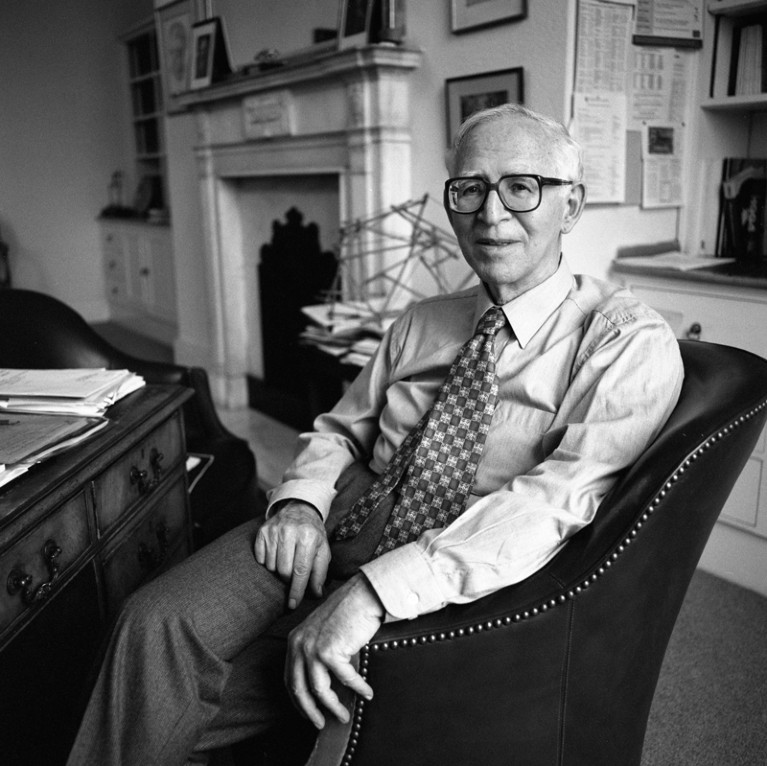
Credit: Anne-Katrin Purkiss
Aaron Klug solved the structures of macromolecules such as viruses, working with chemist Rosalind Franklin. He found the rules of the geometrical form of poliovirus and other spherical viruses. His invention of electron tomography, in which a 3D image of a virus is obtained from many electron micrographs, won him the Nobel Prize in Chemistry in 1982. He discovered proteins called zinc fingers that recognize DNA sequences and initiate the transcription of RNA — work that became the basis of gene therapy.
Between 1986 and 1996, he was director of the Medical Research Council’s Laboratory of Molecular Biology (LMB) in Cambridge, UK. Here he was instrumental in the British part of the Human Genome Project, setting up the Sanger Centre in Hinxton with John Sulston as its director. He was president of the Royal Society from 1995 to 2000, charting a course through crises over bovine spongiform encephalopathy and transgenic crops.
In both jobs he galvanized action and reform. His mild manner belied a tough negotiator. He persuaded the Medical Research Council to allow grant recipients to hold patents. A decade later, income from licences was enough to make the LMB self-supporting. He was knighted in 1988 among myriad other honours. In 2013, the Ben-Gurion University of the Negev established the Aaron Klug Integrated Centre for Biomolecular Structure and Function.
Klug, who died on 20 November, was born in 1926 in Želva, Lithuania. His father was a ranch hand; his mother’s family, the Silins, ran the shop in the shtetl. In 1928 Klug and his parents emigrated to Durban in South Africa. A precocious child, Klug was reading the newspaper aged three-and-a-half. At 15, he won a scholarship to study medicine at the University of the Witwatersrand in Johannesburg (in the same class as another future Nobel-prizewinner and LMB head, Sydney Brenner). Klug switched after a year to natural science and graduated with first-class honours in physics, chemistry and mathematics.
In 1946, Klug did a master’s degree in the physics department at the University of Cape Town with Reginald James, who had worked with Lawrence Bragg, the founding father of X-ray crystallography. James had an enduring influence: Klug came to rely on his friendship and advice. In 1947, Klug published his first paper (A. Klug Nature 160, 570; 1947). Two further papers in Acta Crystallographica on the structure of triphenylene (C18H12) earned him a scholarship to Trinity College, Cambridge. In 1948, he married Liebe Bobrow, a dancer and musician. The next year they left for the United Kingdom.
In Cambridge in 1952, Klug completed a doctorate on the kinetics of steel formation in the lab of physicist Douglas Hartree. The year after, he did theoretical studies on the kinetics of oxygen uptake by the blood pigment haemoglobin with physiologist F. J. W. Roughton. This reawakened his interest in biological phenomena.
Then, in one of the great ‘what ifs’ of science history, Klug was denied a US visa — on the grounds that he had belonged to a student organization that the South African government deemed communist; McCarthyism was at its peak. So in 1953, he moved to London, to the lab of crystallographer J. D. Bernal at Birkbeck College.
Klug met Rosalind Franklin on a staircase there. It was an epiphany: his theoretical gifts combined perfectly with her technical skills. The two collaborated on the structure of tobacco mosaic virus. Their work earned them a grant from the US National Institutes of Health, a rare thing then for an organization outside the United States. After Franklin’s premature death in 1958, Klug took over leadership of the group, working with structural biologist Donald Caspar on spherical viruses.
Such viruses have icosahedral symmetry. The maximum number of molecules that can be evenly assembled on the surface of an icosahedron is 60, but the number found in viruses is always much larger. Klug and Caspar introduced the idea of quasi-equivalence in virus structures, which allows multiples of 60. This was done by inscribing triangles on the surfaces of an icosahedron, an idea borrowed from Buckminster Fuller. All known spherical viruses can be classified in this way.
In 1962, the group moved to the newly founded LMB. Klug and his long-term collaborator John Finch turned to electron microscopy to determine the triangulation number of several spherical viruses. The images were difficult to interpret because of the superposition of the front and back surfaces, which led some to doubt the Caspar–Klug rules. With biophysicist David DeRosier, Klug showed in 1968 how to calculate a 3D image by combining many 2D snapshots of the particle from different angles, deconstructing information in the images using mathematical manipulations called Fourier transforms. The 3D structures showed that Klug’s interpretations were correct. (Computed tomography in medicine was later developed independently by Godfrey Hounsfield and Allan Cormack, a friend and colleague from Klug’s Cape Town days.)
In 1985, Klug discovered modular proteins called zinc fingers. He realized it would be possible to string together many specific zinc fingers to recognize any DNA sequence, which inspired the design of synthetic zinc fingers to target a wide range of diseases. Later, he began working on neurodegeneration, noting the importance of the tau protein in Alzheimer’s disease.
Aaron was a gifted teacher. He had a phenomenal memory and an encyclopaedic knowledge of most things, driven by unbridled curiosity. An admired theoretician, he was assisted by supportive experimentalists throughout his career. Friendly and caring, he inspired loyalty. As director of the LMB he was a valued boss, willing to lend a sympathetic ear. At the Royal Society, three vice-presidents wrote a letter expressing their admiration: “Aaron Klug brings to the Presidency intellectual rigour and integrity, penetrating insights and knowledge of a staggering array of fields, both scientific and cultural.”

 What makes a great lab?
What makes a great lab?







